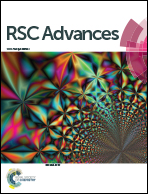Construction of CuInS2/Ag sensitized ZnO nanowire arrays for efficient hydrogen generation†
Abstract
CuInS2 has attracted much attention for application in solar energy due to its small and tunable band gap. It has demonstrated high photoelectric conversion efficiency as a photocathode for solar cells, and it is also suitable for hydrogen generation under visible light (ECBM = −0.44 eV, EVBM = 1.06 eV, vs. NHE). However, there are rare reports of water splitting based on CuInS2. In this work, a simple solution method was designed to decorate a ZnO nanowire (NW) array grown on a FTO substrate with Ag and CuInS2 nanoparticles (NPs). The photoelectrochemical (PEC) activities and hydrogen generation performances were studied. Compared with a bare ZnO NW array, a steady photocurrent increases 100-fold for the ZnO/Ag/CIS system (ZAC) under visible illumination. The solar-to-chemical energy conversion efficiency reaches up to 0.05% with excellent stability. It is expected that this conversion efficiency may be further enhanced several times by increasing the length of the ZnO NWs and controlling the distribution of CuInS2 and Ag NPs on the ZnO NWs.


 Please wait while we load your content...
Please wait while we load your content...